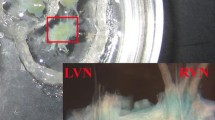Summary
Extracellular single-unit recordings were made from central vestibular units responding to horizontal head rotation in antarctic fish (Pagothenia borchgrevinki) at temperatures below 0 °C. The frequency of head rotation was varied between 0.05–16 Hz and the results were analysed in terms of the phase and gain of the response with respect to the stimulus. The model of the peripheral vestibular system derived by Hartmann and Klinke (1980) was fitted to the data from antarctic fish in order to obtain a quantitative comparison of vestibular function at two different temperatures. Despite the 20 °C temperature difference, and the different recording sites (primary afferents in the goldfish, and central vestibular units in the antarctic fish) vestibular function in antarctic fish is comparable to that previously reported in goldfish.
Similar content being viewed by others
References
Allum JHJ, Graf W (1977) Time constants of vestibular nuclei neurons in the goldfish: a model with ocular proprioception. Biol Cybern 28:95–99
Fernandez C, Goldberg JM (1971) Physiology of peripheral neurons innervating semicircular canals of the squirrel monkey. II. Response to sinusoidal stimulation and dynamics of peripheral vestibular system. J Neurophysiol 34:661–675
Hartmann R, Klinke R (1976) A method for measuring the angle of rotation (movements of body, head, eye, in human subjects and experimental animals). Pflügers Arch (Suppl) 362:R52
Hartmann R, Klinke R (1980) Discharge properties of afferent fibres of the goldfish semicircular canal with high frequency stimulation. Pflügers Arch 388:111–121
Helversen O von, Elsner N (1977) The stridulatory movements of acridid grasshoppers recorded with an opto-electronic device. J Comp Physiol 122:53–64
Macdonald JA, Balnave RJ (1984) Miniature end plate currents from teleost extraocular muscle. J Comp Physiol A 155:649–659
Macdonald JA, Montgomery JC, Wells RMG (1987) Comparative physiology of Antarctic fishes. Adv Mar Biol 24:321–388
Montgomery JC, Macdonald JA (1984) Performance of motor system in Antarctic fishes. J Comp Physiol A 154:241–248
Montgomery JC, Macdonald JA (1985) Oculomotor function at low temperature: antarctic versus temperate fish. J Exp Biol 117:181–191
Montgomery JC, McVean AR (1987) Brain function in antarctic fish: activity of central vestibular neurons in relation to head rotation and eye movement. J Comp Physiol A 160:289–293
O'Leary DP, Dunn RF, Honrubia V (1976) Analysis of afferent responses from isolated semicircular canal of the guitarfish using rotational acceleration white-noise inputs. I. Correlation of response dynamics with receptor innervation. J Neurophysiol 39:631–644
Author information
Authors and Affiliations
Rights and permissions
About this article
Cite this article
Montgomery, J.C., Macdonald, J.A. & Housley, G.D. Brain function in antarctic fish: frequency response analysis of central vestibular units. J Comp Physiol A 166, 407–410 (1990). https://doi.org/10.1007/BF00204814
Accepted:
Issue Date:
DOI: https://doi.org/10.1007/BF00204814



